In software-as-a-service (SaaS) marketing, there’s never a shortage of buzzy trends and “groundbreaking” new strategies.
Most of these trends leave the picture just as quickly as they arrived. So it’s no surprise that some marketers are cautious to go all-in on a new strategy, especially when it requires extra time, resources, and money.
But account-based marketing (ABM) is different.
In a recent study, 76% of companies reported seeing higher return-on-investment (ROI) through ABM than other types of marketing. A different survey found that 86% of respondents say ABM improves win rates.
There are countless other studies that point towards the reality: ABM is more than just a fleeting trend. When executed correctly, an account-based marketing strategy has the ability to drive substantial business outcomes.
At Directive, we’ve adopted ABM as a core function of our marketing activities, both internally and with our clients. After years of trial-and-error, our team has fine-tuned our approach to ABM and developed a three-part framework, built specifically for software companies.
If you’re a software marketer looking to implement ABM at your organization (or level up your existing account-based strategy), this guide’s for you. We’ll break down everything you need to know about account-based marketing, walk you through each step of the framework, and share the results to prove its effectiveness.
Consider this the blueprint for account-based marketing for SaaS.
What is ABM?
The generic definition of account-based marketing (ABM) goes a little something like this:
ABM is a B2B marketing strategy that focuses on targeting only high-value prospect accounts with personalized messaging. It requires tight-knit alignment between both marketing and sales teams to ensure that resources are spent on only the most-qualified accounts.
While this is an accurate definition, we like to put our own spin on it.
At Directive, we define account-based marketing as the acquisition and retention of flagship logos. It’s a go-to-market strategy that requires sales and marketing teams to work together as a cohesive unit that’s focused on one common goal: revenue.
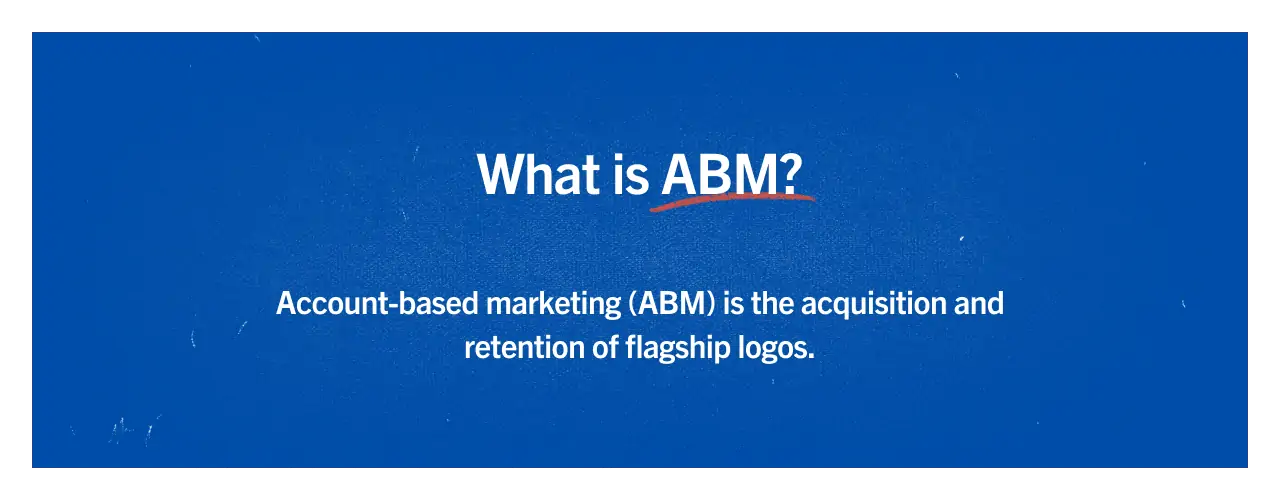
We view retention as a crucial part of the definition because it’s what makes ABM a full-funnel strategy. There’s no doubt that acquisition is essential to growing a business, but we believe that keeping and growing customer relationships is equally as important.
Traditional marketing vs. ABM
The simplest way to understand the nuances of ABM is to stack it up against something most marketers all are already familiar with: traditional marketing.
In traditional marketing, you’re launching campaigns and creating content to attract members of your target audience. The goal? Get them interested enough in your business to enter your funnel as marketing qualified leads (MQLs).
Those leads then get passed off to the sales team to be qualified further and converted into paying customers. Sound familiar?
While this approach is effective, it’s not always the most time or cost-efficient.
You’re essentially casting a wide net and crossing your fingers that your marketing messaging is reaching the right people. This works well for B2C companies, but the B2B buyer’s journey is often much more complicated than that.
Additionally, a growing number of B2B marketing teams are being held accountable for more than just generating MQLs. While the metric is still commonplace, other KPIs such as sales qualified leads (SQLs), sales opportunities, and marketing-influenced revenue help to paint a more accurate picture of marketing performance.
The traditional approach to SaaS marketing might be effective at generating leads, but it’s not always going to translate into paying customers and revenue.
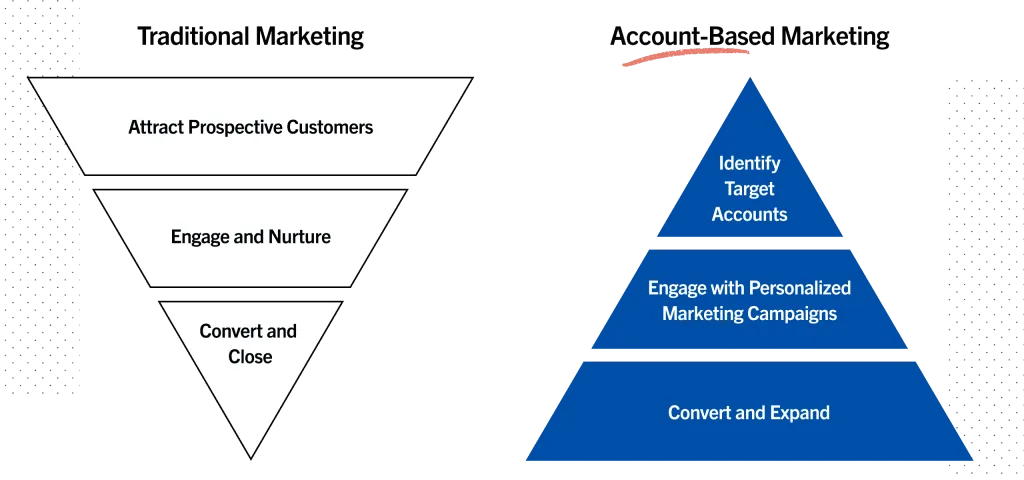
Account-based marketing flips the traditional marketing funnel on its head.
Instead of starting with a massive audience and working your way down, ABM begins with a narrow list of high-value accounts and works toward converting and expanding those relationships.
Since you’re only targeting accounts that have already been pre-determined as a good fit, you don’t have to follow the lengthy sales process that requires passing leads from marketing to sales and qualifying them.
The outcome? You can acquire more logos in less time.
Additionally, when you’re working with a smaller list of accounts, you have the ability to create highly personalized marketing campaigns that speak directly to a company’s unique pain points and attributes.
But ABM doesn’t stop after you’ve converted a lead into a customer.
A full-funnel ABM strategy aims to grow existing customer accounts with the goal of cross-selling and up-selling them in the future. When you expand your marketing resources to nurture current customers, you’re increasing the lifetime value of those accounts and growing revenue as a result.
Account-based marketing for SaaS
At Directive, SaaS marketing is our bread and butter.
We’re the first to hop on a new marketing trend, test it, and see if it lives up to the hype. We do this so you don’t have to.
Many rounds of testing and optimizing our approach to ABM led us to develop this X-part framework:
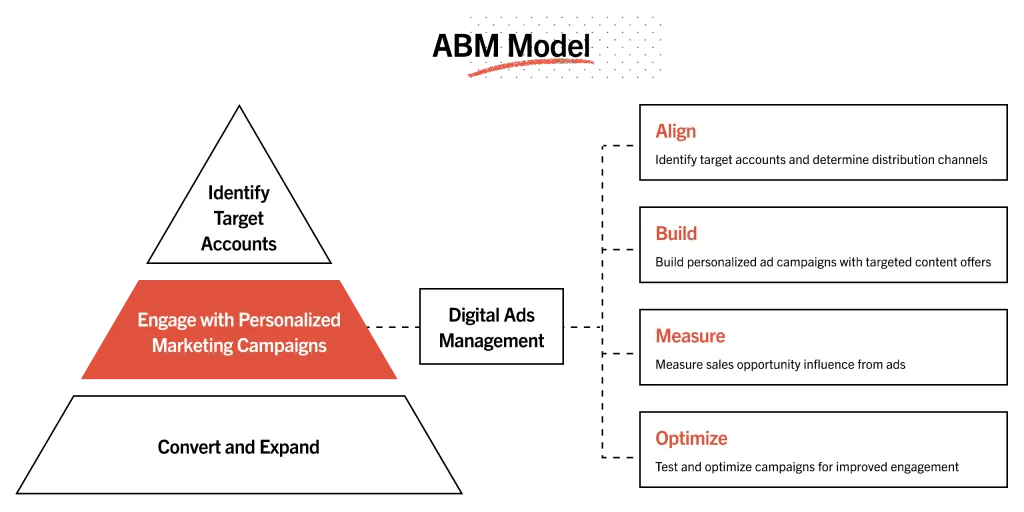
There are countless resources on the web that will walk you through how to set up ABM campaigns. This isn’t one of them.
Instead, you’ll learn how to implement and scale a profitable ABM strategy following our field-tested framework. For the purpose of this guide, we’ll mainly focus on ABM as it’s applied to digital advertising channels. However, many of these principles are applicable to other marketing channels as well.
Let’s get started.
Identify target accounts
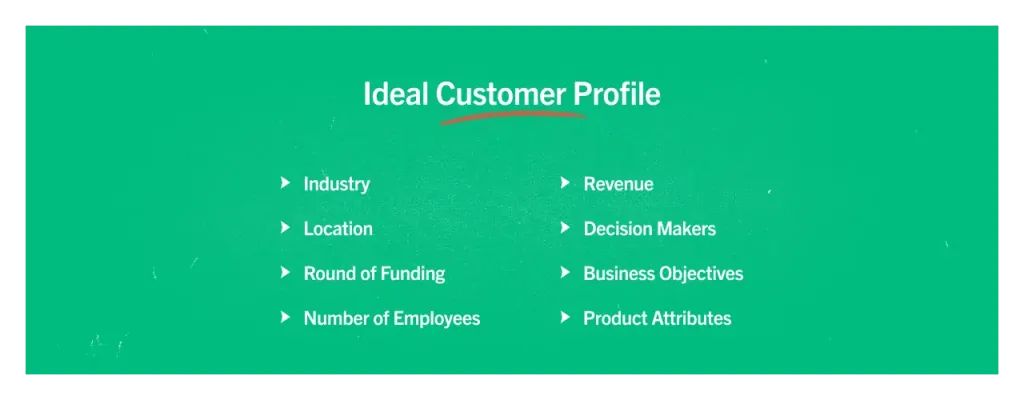
It shouldn’t come as a shock that you can’t do account-based marketing without accounts. But coming to an agreement on which accounts you want to focus on isn’t always simple.
Total addressable market
The first action item is to find your total addressable market (TAM). This is the total amount of revenue that your business can possibly generate within the market you service.
Within the context of ABM, the dollar amount that makes up your TAM isn’t that important. What’s more important is generating a list of accounts that make up your TAM. This is the total number of companies that could potentially turn into customers.
Once you know which accounts make up your TAM, you can start narrowing it down to the companies that are worth going after. Remember that just because a company is within your total addressable market doesn’t mean that it’s going to be a good fit for your business at this time.
Ideal customer profile
When building a target account list, the goal is to find all of the companies in your TAM that fit your ideal customer profile (ICP).
An ideal customer profile is exactly what it sounds like: a hypothetical company that represents your most-valuable customer account. This imaginary company has all the features and attributes that make it the best fit to get value from your solution.
The criteria that make up your ICP should be agreed upon by all internal stakeholders at your organization. This could include marketing, sales, customer success, and even members of your executive leadership team. It’s critical that everyone is on the same page about this, as it’s going to be the foundation of your ABM strategy.
Building a target account list
Once you know what a hypothetical ICP looks like, it’s time to start identifying real accounts that fit the bill.
A good starting point is your customer relationship management (CRM) database.
Comb through your customer lists and take note of common attributes across your most valuable customer accounts. Look at key firmographics such as company size, geographic location, revenue range, and industry.
You can then take these findings and build upon them with a third-party data tool, such as Seamless or ZoomInfo. These solutions allow you to gather additional data points related to the actual people who work at your top accounts, such as job title, level of seniority, and even their contact information.
Combining first and third-party data enables you to paint a full picture of your target account list and the individuals that fall on it.
Account segmentation
Even if you operate within a specific industry niche, your account list can still be massive. For ABM to truly work, you have to get even more narrow with account prioritization.
It’s considered best practice to segment your target account list into tiers. This allows you to prioritize accounts by their likelihood to buy from you. Remember that the goal of an ABM strategy is to allocate the most time and resources towards the accounts with the highest value potential.
For software companies, typically a 3-tier system works best:
- One — Tier one accounts are the companies on this list that fit your ICP to a tee. The accounts that make it on this list are top priority and will require more time and effort when building highly personalized campaigns to go after them.
- Two — Second tier accounts are medium priority. The accounts on this list are missing characteristics that would qualify them to be in the first tier. However, they still match most of your ICP criteria and will require campaigns that are somewhat personalized.
- Three — Tier three is reserved for low priority accounts. Basically, any accounts on your list that don’t fit into tier one or two can be placed here. These accounts can be placed into automated campaigns that don’t require extensive personalization.
The number of accounts within each tier will largely depend on the size of your TAM.
To figure out which account goes into which tier, get more specific with criteria that are most relevant to your ICP.
This can include:
- Firmographics — A set of descriptive characteristics that are used to segment companies into specific groups. Like demographics, but for companies instead of people.
- Technographics — A set of technology-based characteristics that identify a prospect account based on its tech stack.
- Intent — Behavioral data that shows which accounts have shown heightened interest or intent to make a purchase.
Once you have your account list segmented into tiers, you can now prioritize your marketing and sales activities more effectively.
For example, tier three accounts can be sorted into automated marketing campaigns. This frees up your time so you can double down on building more personalized ad experiences for the tier one and two accounts.
Types of account-based marketing
Before you can start thinking about choosing an ad platform and coming up with creative, you have to determine what type of ABM campaign you want to run.
At first, these different subsets of ABM may seem complicated or overwhelming, but it’s really just a way of helping you better prioritize your marketing efforts. Each approach directly correlates with a specific account tier that we discussed earlier, making it easy to determine what type of campaign to use and for which accounts.

There are three types of ABM:
One-to-one
One-to-one, sometimes referred to as strategic ABM, is the process of creating a custom marketing plan around an individual high-priority account. In other words, this means you develop custom messaging and creative assets that are specifically tailored to one highly sought-after prospective customer.
Here’s an example of an ad that we recently ran as part of a 1:1 campaign:
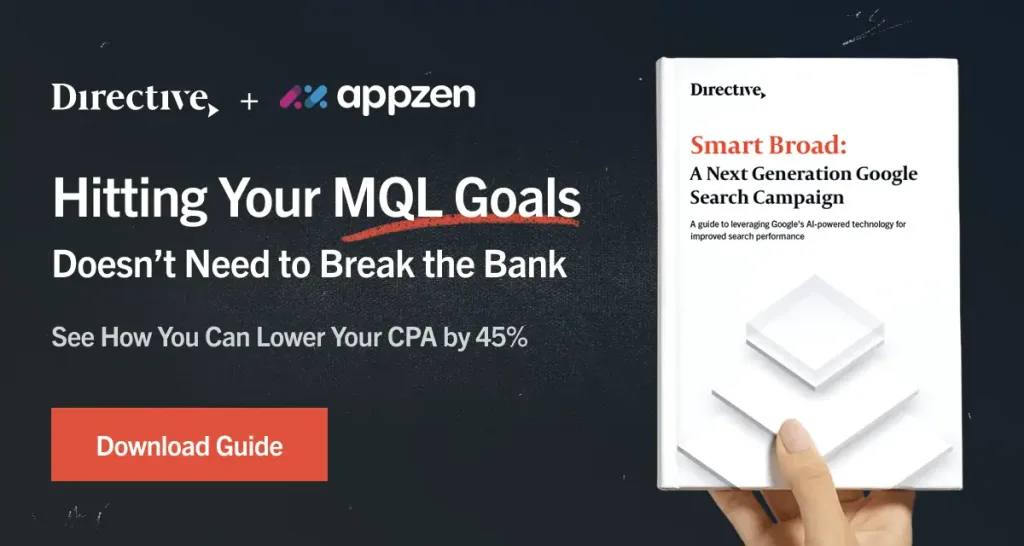
Since this approach requires a high level of personalization, it can be time intensive and difficult to scale. For this reason, 1:1 campaigns should primarily be reserved for a small number of accounts that fall within the first tier of your ABM list. This ensures that the extra time and effort put in is actually worth it.
One-to-few
One-to-few, also referred to as ABM lite, is a type of account-based marketing that’s focused around building a marketing plan to target a small group of accounts with similar attributes.
Since the accounts are grouped together by a common attribute, you can still personalize the marketing plan in a way that’s scalable. For example, companies in the same industry or sub-industry often face similar challenges and opportunities. You can cluster accounts that fall within the same industry and create messaging that’s relevant to all of them. It may not be as personalized as a 1:1 campaign, but still more compelling than something completely generic.
Typically, this approach is applied to tier two accounts that are medium-to-high priority.
One-to-many
One-to-many is a type of ABM that heavily relies on technology to achieve personalization at a large number of accounts. A successful one-to-many strategy requires the use of ABM-specific software that allows for hyper-specific targeting across a very large segment of accounts.
The benefit of this approach is that it allows you to reach a much wider audience. On the other hand, even with the help of technology, it can be difficult to achieve meaningful personalization when targeting a large number of companies. For this reason, this type of ABM should be used primarily for low-priority accounts.
Engage with personalized marketing campaigns
The next phase of building an ABM strategy involves creating campaigns to reach the accounts on your target list.
There are many different ways you can approach campaign development. For the sake of simplicity, we’ll focus mainly on one-to-one and one-to-few campaign types in this guide. The reason for this being that these types of ABM campaigns differ the most from traditional marketing.
At Directive, we’ve honed in on a two-tier approach to campaign creation:
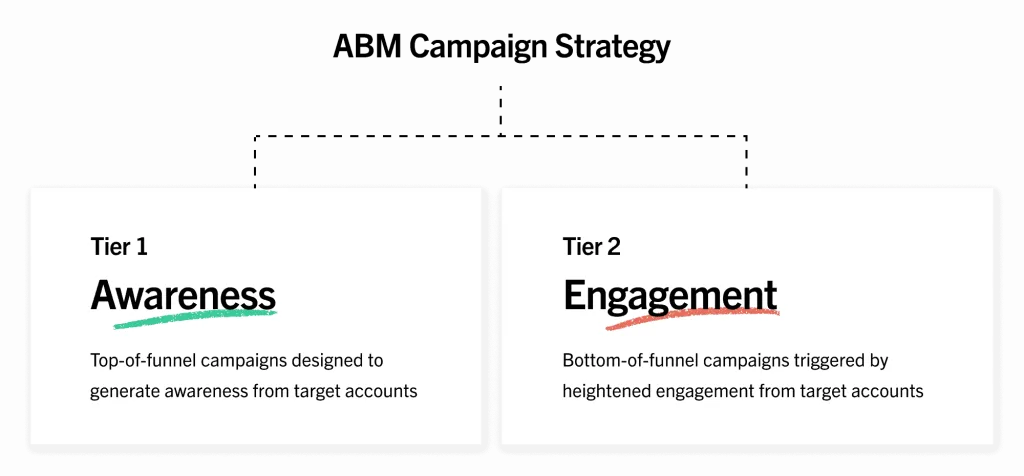
Tier one: Awareness
This is your standard top-of-funnel (ToFu) campaign that’s aimed at generating awareness. This type of campaign is perfect for cold accounts — in other words, companies that have yet to engage or show interest in your brand.
If a majority of the people at an account are unfamiliar with your business, a bottom-of-funnel campaign that promotes a free trial of your software isn’t going to resonate with them. They simply don’t know enough about you yet. They might not even know they have a problem that needs fixing.
Instead, build a campaign that promotes a top-of-funnel offer, such as an ebook download or a webinar registration. This type of offer is less daunting to a cold account because it’s not overtly promotional and provides the user with something valuable and free.
Tier two: Engagement
This type of campaign is reserved for accounts that have shown a heightened level of engagement with your brand.
The definition of “heightened engagement” is going to be different for every business. For example, you can use this type of campaign to target accounts that have had open opportunities with your sales team in the past. Another example would be accounts that have previously entered your database as leads but have failed to move forward in the sales process.
Whatever definition you come up with, the idea is still the same:
Accounts that have shown interest in the past should be served ads with a deeper offer.
What do we mean by a deeper offer?
This refers to an offer that is further down the funnel. For example, a free trial of your solution or a demo request would fall under this category.
When an account has previously shown interest in your business, there’s a good chance that the key internal stakeholders within that company already have some level of familiarity with your brand. A ToFu offer, such as an ebook download, probably won’t resonate with them. Instead, something like a free trial or even access to a competitive comparison report would be much more enticing.
If an account has engaged with your brand before hasn’t led to a conversion yet, think about what you can offer next time that will convince them to come back. Keep sweetening the deal.
– Hannah Mans
Director of Account Based Marketing, Directive
ABM advertising channels
For marketers that are just beginning to dip their toes into the world of ABM, the Directive team recommends starting with these two platforms:
When it comes to advertising for SaaS, LinkedIn reigns supreme.
Marketed to users as a professional social networking platform, it’s easy to understand why LinkedIn has proven to be so successful for B2B advertisers. The platform encourages users to build out their personal profiles with detailed information about their job, position, and skillset. The same goes for businesses — you can find a LinkedIn company profile for just about every business you could think of. This makes it even easier for advertisers to serve ads to the accounts and people they’re trying to reach.
The LinkedIn Ads platform makes it very simple for advertisers to create account-based campaigns. Using its Company Targeting feature, it’s as easy as uploading your ABM account list. The tool will automatically match up your target accounts with existing company profiles and allow you to build campaigns around those pages.
As a bonus, LinkedIn has a variety of audience partners that help with data enrichment and advanced campaign execution.
You could say LinkedIn and ABM are a match made in SaaS marketing heaven.
At Directive, we leverage LinkedIn advertising both internally and with our SaaS clients. It’s continuously proven to be a mega-successful advertising channel for software companies of all sizes and industries.
Time for a quick case study.
We recently developed an account-based LinkedIn campaign for one of our SaaS clients in the healthcare space. Using LinkedIn’s advanced audience targeting options, we were able to deliver our client’s ads to people at their top target accounts and filter by specific job titles, skill sets, and levels of seniority.
Take a peek at the results:
If you’re curious to dive deeper into how we built this strategy, click through to read the full ABM success story.
Facebook and Instagram
Historically, Facebook has been a somewhat challenging channel for B2B.
Its advertising platform, Facebook Ads Manager, has limited targeting options — making it difficult for B2B advertisers to reach the right accounts and audiences. Since Facebook owns Instagram, we group these platforms under the same category. Some might argue that Instagram is even more challenging for B2B, as it’s even more heavily focused on lifestyle and consumer content.
Clearbit integration
Clearbit is a data vendor that provides sales and marketing teams with advanced tools built to capture and enrich customer data.
In 2020, the data provider launched an integration with Facebook that allows for LinkedIn-level targeting on the social networking platform. The integration allows advertisers to create dynamic audiences with over 100 different targeting options that are unique to B2B. This includes job title, seniority, and even company revenue or employee count.
Before rolling it out to our clients, we tested the Facebook/Clearbit integration internally on our ABM accounts. After a few initial rounds of testing, we saw promising early results:
Using Clearbit-enriched data, our team was able to reach the same ABM audiences as we do on LinkedIn but at a fraction of the cost. We believe there’s a massive potential for SaaS businesses to leverage this integration and achieve similar ABM results.
Attention-driven ad creative
All the time you spent segmenting your account list and building campaigns could go to waste if your ad creative falls flat.
At Directive, we view creative as a major driver of campaign performance. Research shows that people are exposed to nearly 5000 advertisements a day — that’s a lot of competition.
For marketers, this means you have to go the extra mile to ensure your ads are visually striking enough to command attention. Just because it’s B2B doesn’t mean it has to be boring!
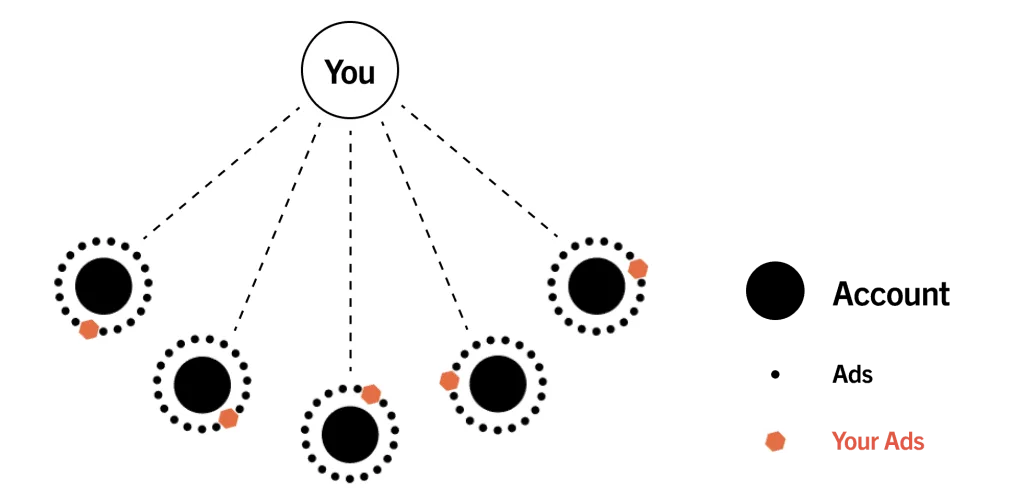
However, there’s a catch.
Creative is subjective. What’s visually appealing to one person could be dull and uninteresting to the next.
Luckily, there’s a fairly effective workaround: A/B testing.
A/B testing, also known as split testing, is the process of running an experiment that compares two or more variants against each other to determine a winner.
Marketers have the ability to A/B test different ad designs and copy variants to determine which ones resonate the most with a specific audience.
At Directive, we aim to test different creative variants with every ABM campaign. What resonates with one account could be a complete flop with a different company. Running tests allows you to gather deeper insights about your audience, their interests, and what they care about.
With creative, I always try to switch it up. You should always be testing something new. Every company is different, so you can’t rely on the same creative to resonate with everyone.
– Tim Davidson
Senior PPC Manager, Directive
Measuring ABM performance
When it comes to metrics and performance, ABM campaigns aren’t much different than other types of marketing campaigns.
The exact metrics you choose to track could vary depending on the objective of the campaign. For the most part, however, all of these varying smaller metrics should roll up to primary KPIs: marketing influenced sales pipeline and revenue.
This could be a big change if your marketing team isn’t used to being held accountable to a revenue number.
On a more granular level, here are some additional key metrics to keep an eye on:
Account engagement
This is a way to measure which accounts are interacting with your brand.
The actual data points you use to measure account engagement should be unique to you and your business.
Here are some examples of activities that could contribute to account engagement:
- Website visits
- Time on page
- Brand impressions
- Form fills
- Chat bot interactions
- Phone calls
- Webinar registrations
- Email opens
As you can see, these inputs are pretty across the board. The ones you choose to take into account will largely depend on the campaigns you’re running and the channels you’re focused on.
Many ABM platforms come with a built-in scoring feature that automatically assigns an engagement score to your accounts based on similar intent signals.
Average order value
Average order value (AOV) is a measure of the average dollar amount that a customer spends throughout the lifetime of the business relationship.
Since you’ve spent considerable time and resources vetting and prospecting ABM accounts that fit your ideal customer profile, the average lifetime value should increase over time.
If your AOV stays the same or decreases, it’s a sign that your ABM efforts are ineffective. You could have maintained the same sales and marketing activities as before and achieved the same results. This means it’s time to go back to the drawing board and re-evaluate whether the accounts you’re targeting in your ABM campaigns are truly the right fit for your business.
Customer churn rate
Churn rate is the rate at which customers stop doing business with you.
For every account that signs on with your business, the goal should be to keep them as a paying customer for as long as possible. A high churn rate could be a sign of problems with your product, bad implementation processes, or inadequate customer service operations.
Whatever the case may be, it’s an indicator that your customer relationships are suffering. And it means that you need to step your ABM efforts on the customer front.
You may notice that there’s something missing from this list: MQLs.
With ABM, you hand-select accounts that are a good fit for your business. This effectively pre-qualifies these accounts, meaning you can bypass the traditional lead qualification process.
The result? Speedier sales cycles.
Account-based marketing software
As with many modern marketing strategies, there are a few core technologies required to execute a successful ABM program.
In a perfect world, every marketing department would have an endless budget and have the ability to build the ultimate ABM stack.
In reality, most marketers are usually working with a tight budget. Plus, it can be difficult to get executive approval for additional software tools — especially if the overarching strategy is still new or unproven.The good news is that you don’t need every software tool on the market to be successful at account-based marketing. That said, if you do have a budget for ABM software, here are a few tools worth looking into:
For additional options, we suggest heading to G2 for an overview of different ABM software solutions that could be a fit for your business.
Convert and expand
As we mentioned earlier, your ABM strategy doesn’t stop after a target account converts to a customer.
Many SaaS businesses operate on a subscription model — meaning customer retention is equally as important as acquisition.
As a software marketer, your job doesn’t end when a deal is closed. It’s actually just beginning. To keep customers happy, build loyalty within the organization, and give your customer success team a shot at renewing the contract, you have to go the extra mile and continue building relationships at the account level.
This is especially true if your primarily customer accounts are mid-market or enterprise. The bigger the company, the more likely it is that you’re working with multiple internal stakeholders throughout the duration of the relationship. It’s very possible that the person who was initially sold on your solution isn’t going to be the main point of contact. It’s also possible that by the time the renewal comes around, one or more of the primary contacts have left the company.
This type of situation is pretty common in the SaaS industry and it can be a big contributor to churn.
For this reason, it’s critical that marketing works closely with customer success to align on ABM campaigns that are built specifically for the purpose of expanding relationships at customer accounts.
Good marketing won’t repair a bad product or poor customer service, but it can help communicate the value of your solution at a deeper level within the customer organization.
On the customer side, the same ABM principles still apply. It’s more about what you can show them that will catch their attention. Do you have a new product or a new feature that you recently launched? Things like that.
– Tim Davidson
Senior PPC Manager, Directive
Conclusion
SaaS is booming.
And regardless of industry, many software categories are growing increasingly more competitive. New vendors are popping up every day.
Don’t waste your valuable time and resources on generic marketing campaigns that aim to reach as many people as possible. With ABM, less is more.
By implementing an account-based approach, software marketers and salespeople can feel confident that their efforts are focused on only the highest-value companies. This makes for more efficient use of resources and the opportunity to unite your sales and marketing teams into one cohesive revenue-generating unit.
The best part?
You don’t need fancy tools or expensive software to get started with ABM.
Using the framework outlined in this guide, you can start to form the building blocks of your own ABM strategy. Then, start applying it to real marketing campaigns and continue optimizing your strategy as the results roll in.
With time, patience, and a bit of trial-and-error, you’ll be on your way to acquiring more logos in less time and keeping those customers around for longer.
Ready to Join a Growing Community of SaaS Marketers?